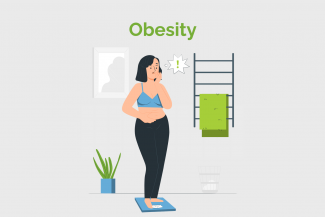
Tests for Obesity Diagnosis
- The measurement tools mentioned below are used to classify obesity.
- Blood tests for associated risk factors like cholesterols levels and blood sugar levels.
- Liver fat analysis.
- Bone density analysis.
Body mass index (BMI):
It is calculated as a person's weight in kilograms divided by the square of their height in meters (kg/m2).
WHO/US criteria label BMI 25–29.9 as overweight and ≥30 as obese.
Indian and Asia-Pacific guidelines lower these thresholds to overweight at BMI ≥23 and obesity at ≥25.
Waist Circumference:
As stated by WHO, WC > 94 cm in men and >80 cm in women is associated with an increased risk of metabolic complications.
This risk is significantly increased with a WC > 102 cm in men and >88 cm in women.
Asian cut-off is lower with males>90 cm and females>80 cm.
Hip circumference (HC):
Hip circumference is measured at the level of the widest circumference over the greater trochanters. This is done using a flexible narrow non-stretch tape. For measuring this circumference, the subject must be measured in a standing position at the end of a gentle expiration.
Waist-hip ratio (WHR):
The WHR is a straightforward indicator of central obesity.
The WHO classifies abdominal obesity in men as having a waist-to-hip ratio of at least 0.90. For women, the ratio is 0.85 or higher. A ratio greater than 1.0 for either sex indicates a significantly increased risk of health complications.
Wrist circumference (WrC):
WrC is thought to be a distinct fat distribution indication.
WrC with a cut-off of the 97th percentile is a good technique for identifying metabolic syndrome in overweight children and adolescents.
Neck circumference (NC):
Neck circumference can be used as an initial screening technique for overweight/obesity.
Men with an NC of 34.75 cm and women with an NC of 31.75 cm are considered overweight, whilst men with.
The optimum cut-off values for obesity were NC 35.5 cm in males and NC 32 5 cm in women.
Body fat percentage (Body composition analysis):
Body fat percentage of more than 25% in men and more than 30% in women are considered obese according to the endocrine society of India.











